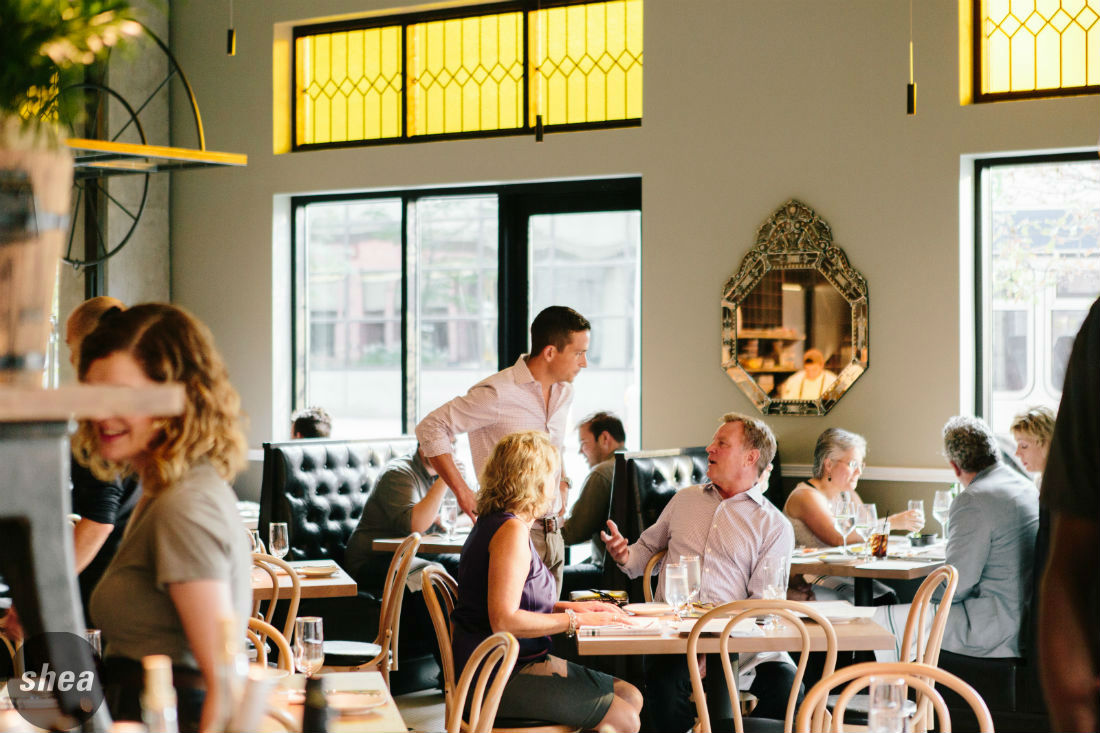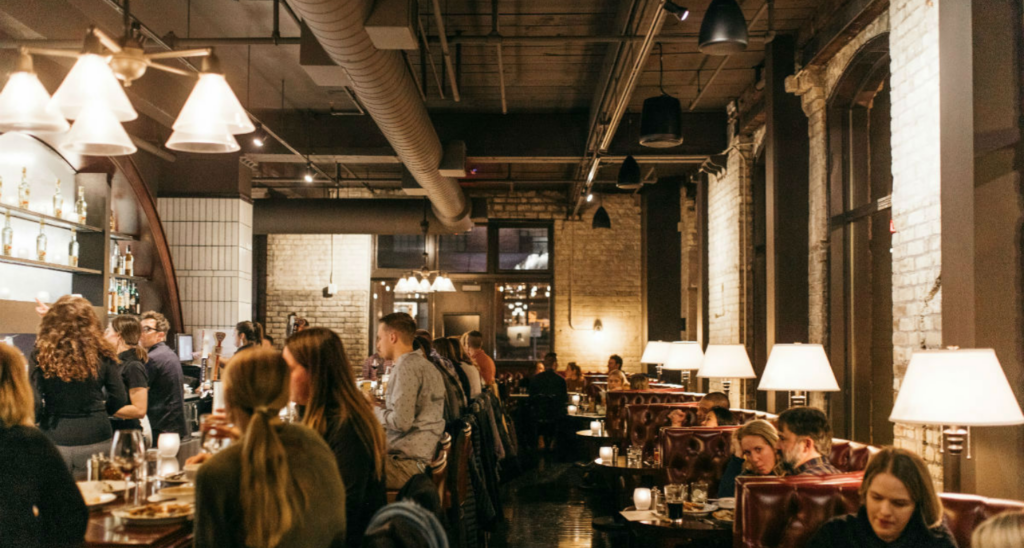Cheers. The Peach Pit. Central Perk. Finding the perfect neighborhood spot is an art. It has to be easy rather than fussy. And it has to be convenient, without sacrificing style or experience.
Creating the perfect neighborhood spot? That’s even tougher. Taking an area’s vibe and translating it into an everyday space for locals—while drawing people in from other neighborhoods—is a tricky balance. But the development of three recent Shea projects—each filling a unique need in a unique area—show that we’re up to the challenge.
Eastside: Detailed Comfort
Eastside was created to be a neighborhood spot, an anchor for a newly defined neighborhood in which people have been living for years. The restaurant has a lot going for it in that respect, from name (fittingly located in that newly branded Downtown East neighborhood) to chef (Remy Pettus, pulled from the Cosmos kitchen, grew up in the ’hood before it was hot and considers this a homecoming) to food (an approachable mix of raw and cold, small and large plates that put fresh spins on comfortable favorites). It’s a brasserie for the American set, a go-to spot for neighborhood dwellers and those living in the apartments above, but it’s still special enough to warrant a trek across town.
To achieve this, the environment at Eastside needed to be as convivial as any neighborhood bar’s, but with that something extra—touches of visual interest, intriguing textures, and details that serve as conversation pieces. It’s here where Shea design director Cori Kuechenmeister and her team excelled. The key pieces needed to be understated enough that they wouldn’t produce sensory overload: black tufted booths and light-wood tables and chairs accented in black.
But extras put the restaurant over the top, not only in terms of design (a Shea-designed intricate pattern of tiny hexagonal tiles) but comfort (an elbow ledge on the edge of the bar makes it possible to lean all evening). It’s the quirks at Eastside that make it fun and comfortable, from the cozy two-top near the entrance offering a new viewpoint on the kitchen to the Pegasus-inspired bar footers.
Eastside gets its neighborhood cred not only from its roots but its sense of intimacy. We wanted to create a relationship between cook and diner, so the open kitchen extends into the dining space. A couple of tables directly off the cooking line give a chef’s-counter experience in a four-top setting, facilitating conversation while still giving a view of the culinary ballet being performed just inches away.
Beyond the bar, some of the best seats in the house (at drink ledges adorned with caged lights from local maker Wild Horse) don’t require reservations. The 127-seat space includes guests at every seat and angle, the key to a truly great neighborhood spot: Whether diners are seated at the bar, which culminates in a communal table at one end, the artisan-crafted chef’s table, or the flip-out bar that opens to create indoor/outdoor space with the front patio, the chic-but-unintimidating vibe is exactly what keeps them coming back, and it’s the same attitude that the burgeoning neighborhood embodies.
4 Bells: Offering Options
You want people to keep coming back to your restaurant? Then it needs to be a place they’re always in the mood to go. Somewhere with a vibe that isn’t tiring, and a restaurant with something for everyone—whether it’s a special occasion or a typical Tuesday. Welcome to 4 Bells in Loring Park.
Cori and her team wanted the large restaurant to feel open and airy, but with the opportunity to draw people looking for different experiences. The solution? Split the space into a handful of dining areas, each with its own atmosphere designed to match a different mood. Upon entering, a sleek, energetic bar area is an ideal gathering spot for an impromptu night out, while the lounge area behind the entry is more intimate, with dark-paneled walls and black leather banquettes.
The main dining room is all about activity, and the curved raw bar is exactly where to go if you’re looking to interact with chefs in the open kitchen. The adjacent dining room overlooks the park, and private(ish) dining spaces range from tables set just off the main path to next-gen board rooms on the second floor.
Outdoor spaces offer even more relaxed spots to settle in for the evening. Seasonal patio seating gives a great parkside view, and then there’s the hero rooftop. It boasts a separate menu and completely different atmosphere, with a more casual, down-home vibe, and takes advantage of the awesome view of the nearby Basilica. Best of all? It’s fully enclosed, climate-controlled, and dog-friendly. And in keeping with the client’s desire to keep the ’hood happy with deep-fried food, opening next spring will be the Coop, a walkup, takeout window slinging only fried chicken and beer—a jumping-off (or finishing-off) point for a perfect summer night.
Despite the varying ambiances, though, design details throughout keep the restaurant cohesive. Architectural salvage pieces and intricate light fixtures draw attention in each section, and wood wall panels and continuous hardwood flooring throughout the space lend a classic, timeless vibe. Unique bartops dominate all three bar areas, but each expresses its own personality: The main bar features an elegant mahogany counter with a zinc edge, while the oyster bar is crafted from stainless steel and cut to resemble watch links. And the rooftop bar is made of heavily inlaid wood to echo the informality of the space. There are a lot of scenes being set at 4 Bells, but there’s never a disconnect in the overall experience—an ideal neighborhood hangout because there’s somewhere to go no matter what mood you’re in.
Davanni’s: Convenient and Classy
Davanni’s has always been known as a neighborhood joint—it wasn’t Shea’s job to turn it into one when we gave the brand a big refresh for its 40th birthday this year. What we had to do was bring back the local, legendary vibe that had faded into dull monotony over the years, starting with a repositioning of the Edina location before rolling out the full design at the recently opened Chanhassen store. We had to make people want to hang out there again, to want it to be their go-to spot.
Creating a space that invites people back begins with a design that welcomes them in the first place. The former Davanni’s counters were clunky, overwhelming customers as soon as they entered the restaurant. Our new iteration is lower-profile and pushed back away from the door, inviting customers to come in and interact and engage with the employees and the space—and re-designed menu boards make ordering easy rather than head-spinning.
And then you need to get people to stay. “When we were talking with Shea, we really wanted the new look to give a comfortable place to hang out,” says Davanni’s co-owner Kristy Silva. “Delivery is a big part of our business, but we wanted to make the dining-in experience more appealing for people to come in, have dinner, and stick around for a bit.”
As a main focal point, we added a bar with seating to engage diners right away. It also helps drive sales of craft beer and wine (a recently introduced bar program that’s been a major emphasis for the brand refresh). Warm, rich materials and a color palette of vibrant red set against clean white are comforting, while French doors and subway tile add a contemporary spin. “I think that in the locations with the new finishes, it’s an easy, in-the-neighborhood place to go that’s not just close and convenient—the design makes it feel special and higher-end,” says Silva.
By shifting the Davanni’s design and branding, we created a new experience for consumers. Now it’s a place to experience rather than one for grabbing a pizza and heading home—a neighborhood place with personality.



